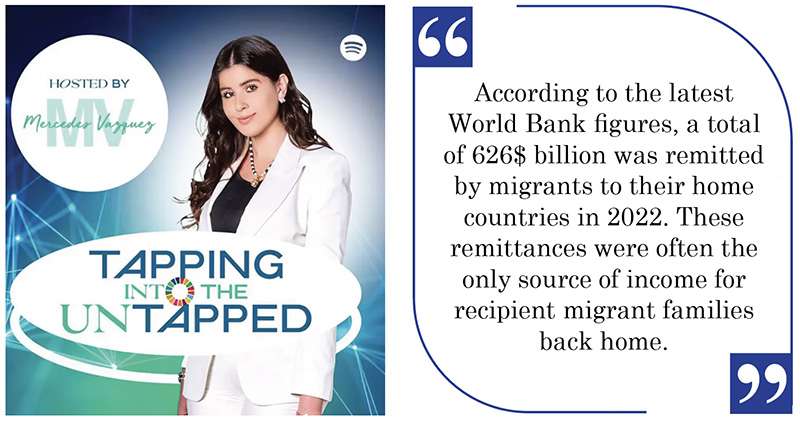Tapping into the untapped
By Mercedes Varquez
Special to The Times Kuwait
With more than 15 years of experience at the United Nations agency, International Organization for Migration (IOM), Mazen AboulHosn, the IOM chief of mission in Kuwait, has extensive experience on issues related to migrants and migration, as well as on various aspects of human trafficking.
In a recent talk with Mercedes Vazquez, creator of the podcast, ‘Tapping into the Untapped’, the IOM Chief in Kuwait said that the intergovernmental organization was committed to the principle that humane and orderly migration benefits migrants and society.
“The IOM, which was established in 1951, is part of the United Nation system. We support migrants around the world, and we are also a key source of advice on migration, policy and practice. And, we also work in emergency situations, with a majority of our work now focusing on responding to crises around the world,” said AboulHosn by way of introducing IOM and its activities.
“In Kuwait the organization was established in 1991, and in 2017, Kuwait became an IOM observer state. Kuwait is a donor country for our work responding to many humanitarian operations. And we also work with Kuwait on several migration topics including migration governance, labor migration, and in countering human trafficking, as well as in the implementation of the objectives of the Global Compact on Migration (GCM),” said the IOM Chief of Mission.

Elaborating on global mobility and its latest trends, AboulHosn said: “Migration is a very complex issue, and sometimes it can be exacerbated by misinformation and politicization, and this is something that can be alarming sometimes. Migration is also shaped by various factors, including economic, geographical, and demographic, among others. So it is not accurate to consider migration from only one aspect, or treat it as a single homogenous issue.
“If we look at some trends in migration nowadays, the estimate is that there were around 281 million international migrants in 2020, which was then almost 3.6 percent of the global population.
“If we look at the region with the largest number of migrants, Europe tops the list with 30.9 percent of the international migrant population, followed by Asia with 30.5 percent, North America, 20.9 percent, and Africa with 9 percent of total migrant population.
“Looking at migration based on corridors along which migrants travel, as they move from their country of origin to the country of their choice, one can see distinct pathways. The largest migration corridor is from Mexico to the United States, followed by the migration of people from Syria to Turkey — but in this case the refugees are mainly Syrian refugees displaced to Turkey. The third largest migrant corridor is that from India to the United Arab Emirates, where again it is mainly labor migrants. In addition to international migrants there are also around 103 million people who are internally displaced within the borders of their own countries, and then there are the refugees.
“Safe, orderly and regular migration as outlined by the GCM is also a key component in realizing the 17 United Nations Sustainable Development Goals (SDGs). Although SDG indicator 10.7 concerns safe and orderly migration, migration is a cross-cutting issue in all 17 SDGs. So a lot of work we currently do is on mainstreaming migration and development, and highlighting the value of migrants to societies they live and work in, and the important role migrants play in helping countries, both their source and destination places, to achieve their SDGs.
“According to the latest World Bank figures, a total of $626 billion was remitted by migrants to their home countries in 2022. These remittances were often the only source of income for recipient migrant families back home,” said Mr. AboulHosn.
Turning to how climate change repercussions were contributing to the displacement of people and the need to raise awareness on the multi-dimensional impact of climate change in reshaping our world, AboulHosn said: “Changes in temperature, rising sea levels, increase in frequency and intensity of rains, droughts and sandstorms are leading to a hike in the number of people being displaced around the world.
“When combined with physical, social and environmental vulnerabilities climate change may undermine food, water and therefore economic security. All of which are pillars for our safety and welfare as humans, and also for achieving the SDGs.” In 2021, globally 22.3 million people were displaced because of weather related disasters such as storms, floods, wildfires and droughts. And the prediction is that by 2050, in North Africa alone, internally displaced climate migrants could number around 9 percent of the total projected population in this sub-region.
“By 2050, without concrete climate and development action, effects of climate change can induce displacement, loss of livelihood, especially those sectors such as agriculture and tourism that rely heavily on weather and climate. It can weaken governance and increase competition over natural resources. And in some cases, it can also lead to political instability and conflict.
“And what is also more important is that the number of internally displaced climate migrants could be reduced through aid, migration-support actions, evidence based research to understand the drivers of climate change, and to plan for each phase of migration through positive adaptation.
That’s why we initiated the Institutional Strategy on Migration, Environment and Climate Change. It is a strategy for 2021-2030 and its main purpose is to respond to major changes that occur in global, regional, national discussions on migration, environment and climate change. In particular, we are trying to base it on evidence and the knowledge that we generate from across the world,” concluded the IOM Chief in Kuwait.

















